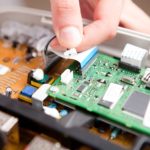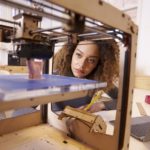Makers: if you can dream it, you can build it
The so-called Maker Movement is known for creating craft objects using technology like robotics, 3D printing or laser. This trend is fighting to go from a simple hobby to a business opportunity.

The U.S. company 3D Robotics is leading the drone market, together with China’s DJI and France’s Parrot. What distinguishes the U.S. company from the other two, apart from its turnover and the design of its Unmanned Aerial Vehicles (UAVs) – is that it was established by Mexican Maker, Jordi Muñoz, who at the age of 19 was already hacking his Nintendo Wii and remote control helicopters from his bedroom.
An adolescence that seems like it came straight out of a soap opera brought him from his native Mexico to the U.S. Muñoz went online every night and shared information on DIY drones in the Maker forum. There he met Chris Anderson, then Editor-in-Chief at the tech magazine Wired. Anderson managed to convince him to start building drones. As he told Forbes, after a lot of “trial and error, trial and error, one year later, it worked. It was the happiest day of my life. The day I sat down, set the controls and the plane was flying by itself.” It was early 2009. In May of the same year they were already selling drones. 3D Robotics currently has a turnover of $20 million a year.
Makers are known for using digital manufacturing for their projects and for their Do It Yourself (DIY) slogan. It’s a movement that started in 2006. Dale Dougherty, one of the founders of the Maker Movement, as well as the founder of Maker Magazine and organizer of the Make Faire meetings, compares Makers to music lovers: very few are considered professionals but many play instruments at home or in public.
“I connect with people so they can make their dreams come true, even if mine is on stand-by
Makers form the base of the pyramid and the famous inventors and innovators are at top. Dougherty feels that the base of the pyramid is doing things that are similar to those at the top. He wants the innovations taking places in people’s garages to also be visible so they can become a success story like Jordi Muñoz.
César García Sáez, co-founder of Makespace Madrid, explained at the 2016 Trends Spain event organized by Google that the key elements of the Movement include:
- Creating something with your own hands that makes sense for you. Makers don’t express themselves with words or by painting, but through creation.
- Share what is made and known with other people.
- Never stop learning.
- Have fun making prototypes. Never think that the prototype is going to be a success. Learn by playing and experimenting.
- Participate in the group. Almost no one creates by themselves. Makers meet in physical locations (FabLabs) or online spaces, but always as a community. Don’t explore technology alone.
- It’s a movement with a goal: “We represent the best hope to improve the world. We are responsible for a new future.”
- The movement uses digital manufacturing. We create three dimensional pieces and work with data that becomes something physical.
García Sáez feels that being a Maker is a way of life, something he also shares with another Makespace Madrid founder, Sara Alverellos. Alverellos shared her experience at the event, held at BBVA’s Innovation Center in Madrid. “If you can dream it, you can build it,” said the architect.

Just like Muñoz, Arduino has changed Sara Alverellos’ life. “Arduino is a microcontroller board that lets us make prototypes of our inventions. It uses sensors to obtain information from the environment, causing the components to move. It’s a sort of connector between the physical and digital world.”
In the history of the Maker Movement, she feels that “Arduino was a turning point,” since the low-cost microcontroller board was designed to allow artists and designers to do programming.
For this Maker, “Arduino revolutionized inventors by giving us a tool with open-source hardware to learn to do programming.” As described in this article in El País, Arduino circuit boards are all over the world. They are used in 90% of free 3D printers, in medical devices, automation, robots, wearables and countless educational projects.
The formula for its success lies in the affordability of its products, as Makers can start with one of its modules for around €30. They work with any platform since their software runs on Windows OSX and Linux. The programming environment is clear, simple and flexible and it’s easy for a newcomer to understand, yet it can also be made it extremely complex. And the software is open source (free and modifiable) and so is its hardware.
Sara Alverellos emphasized that the challenge for the Maker culture is to make prototypes that become part of real life. She tried it in 2009 with a project to make toy parts for 3D printing, but had to put the project on hold. She gave up because it was difficult to find hardware in Spain since the market is focused on software.
Now, “I connect with people so they can make their dreams come true, even if mine is on stand-by,” she adds.